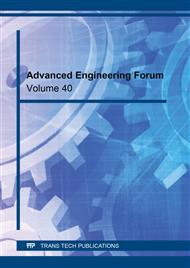[1]
L. Arturo Soriano, W. Yu, and J. d. J. Rubio, Modeling and control of wind turbine,, Mathematical Problems in Engineering, vol. 2013, (2013).
DOI: 10.1155/2013/982597
Google Scholar
[2]
M. Beus and H. Pandžić, Application of Model Predictive Control Algorithm on a Hydro Turbine Governor Control,, in 2018 Power Systems Computation Conference (PSCC), pp.1-7, (2018).
DOI: 10.23919/pscc.2018.8442594
Google Scholar
[3]
P. A. Gbadega and A. K. Saha, Model predictive controller design of a wavelength-based thermo-electrical model of a photovoltaic (PV) module for optimal output power,, in International Journal of Engineering Research in Africa, pp.133-148, (2020).
DOI: 10.4028/www.scientific.net/jera.48.133
Google Scholar
[4]
P. A. Gbadega and A. K. Saha, Impact of Incorporating Disturbance Prediction on the Performance of Energy Management Systems in Micro-Grid,, IEEE Access, vol. 8, pp.162855-162879, (2020).
DOI: 10.1109/access.2020.3021598
Google Scholar
[5]
M. S. Mahmoud, M. S. U. Rahman, and M.-S. Fouad, Review of microgrid architectures–a system of systems perspective,, IET Renewable Power Generation, vol. 9, pp.1064-1078, (2015).
DOI: 10.1049/iet-rpg.2014.0171
Google Scholar
[6]
S. Sahoo, B. Subudhi, and G. Panda, Optimal speed control of DC motor using linear quadratic regulator and model predictive control,, in 2015 International Conference on Energy, Power and Environment: Towards Sustainable Growth (ICEPE), pp.1-5, (2015).
DOI: 10.1109/epetsg.2015.7510130
Google Scholar
[7]
A. Alzahrani, M. Ferdowsi, P. Shamsi, and C. H. Dagli, Modeling and simulation of microgrid,, Procedia Computer Science, vol. 114, pp.392-400, (2017).
DOI: 10.1016/j.procs.2017.09.053
Google Scholar
[8]
U. Maeder, F. Borrelli, and M. Morari, Linear offset-free model predictive control,, Automatica, vol. 45, pp.2214-2222, (2009).
DOI: 10.1016/j.automatica.2009.06.005
Google Scholar
[9]
Henriksen, L. C., Poulsen, N. K., & Hansen, M. H. Model Predictive Control of Wind Turbines,. Kgs. Lyngby, Denmark: Technical University of Denmark (DTU). (IMM-PHD-2010-244), DTU Informatics, (2011).
DOI: 10.13052/jsame2245-4551.2018003
Google Scholar
[10]
A. Alzahrani, P. Shamsi, M. Ferdowsi, and C. Dagli, Modeling and simulation of a microgrid using feedforward neural networks,, in 2017 IEEE 6th International Conference on Renewable Energy Research and Applications (ICRERA), pp.1001-1006, (2017).
DOI: 10.1109/icrera.2017.8191208
Google Scholar
[11]
R. A. Waltz, J. L. Morales, J. Nocedal, and D. Orban, An interior algorithm for nonlinear optimization that combines line search and trust region steps,, Mathematical programming, vol. 107, pp.391-408, (2006).
DOI: 10.1007/s10107-004-0560-5
Google Scholar
[12]
L. C. Henriksen and N. K. Poulsen, An online re-linearization scheme suited for Model Predictive and Linear Quadratic Control,, DTU Informatics, pp.1-14, (2010).
Google Scholar
[13]
C. L. Bottasso, A. Croce, B. Savini, W. Sirchi, and L. Trainelli, Aero-servo-elastic modeling and control of wind turbines using finite-element multibody procedures,, Multibody System Dynamics, vol. 16, pp.291-308, (2006).
DOI: 10.1007/s11044-006-9027-1
Google Scholar
[14]
L. C. Henriksen, M. H. Hansen, and N. K. Poulsen, Wind turbine control with constraint handling: a model predictive control approach,, IET control theory & applications, vol. 6, pp.1722-1734, (2012).
DOI: 10.1049/iet-cta.2011.0488
Google Scholar
[15]
L. C. Henriksen, N. K. Poulsen, and M. H. Hansen, Nonlinear model predictive control of a simplified wind turbine,, IFAC Proceedings Volumes, vol. 44, pp.551-556, (2011).
DOI: 10.3182/20110828-6-it-1002.02070
Google Scholar
[16]
S. Georg, H. Schulte, and H. Aschemann, Control-oriented modelling of wind turbines using a Takagi-Sugeno model structure,, in 2012 IEEE International Conference on Fuzzy Systems, pp.1-8, (2012).
DOI: 10.1109/fuzz-ieee.2012.6251302
Google Scholar
[17]
A. Gosk, Model predictive control of a wind turbine," Master,s thesis, Technical University of Denmark, (2011).
Google Scholar
[18]
S. Nimmagadda, A. Islam, S. B. Bayne, J. Sanchez, and L. Garcia Caballero, Improvements in the modeling of wind turbines in power system studies,, Journal of Renewable and Sustainable Energy, vol. 7, p.043147, (2015).
DOI: 10.1063/1.4928678
Google Scholar
[19]
P.A. Gbadega and A.K Saha, Effects and Performance Indicators Evaluation of PV Array Topologies on PV Systems Operation Under Partial Shading Conditions,, in 2019 Southern African Universities Power Engineering Conference/Robotics and Mechatronics/Pattern Recognition Association of South Africa (SAUPEC/RobMech/PRASA), pp.322-327, (2019).
DOI: 10.1109/robomech.2019.8704823
Google Scholar
[20]
H. Wen and R. Yang, Modeling and simulation of energy control strategies in AC Microgrid,, in 2016 IEEE PES Asia-Pacific Power and Energy Engineering Conference (APPEEC), pp.1469-1474, (2016).
DOI: 10.1109/appeec.2016.7779734
Google Scholar
[21]
E. Hamatwi, I. E. Davidson, M. Gitau, and G. Adam, Modeling and control of voltage source converters for grid integration of a wind turbine system,, in 2016 IEEE PES PowerAfrica, pp.98-106, (2016).
DOI: 10.1109/powerafrica.2016.7556579
Google Scholar
[22]
A. J. Larsen and T. S. Mogensen, Individuel pitchregulering af vindmølle,, Technical University of Denmark, DTU, DK-2800 Kgs. Lyngby, Denmark, (2006).
DOI: 10.13052/jsame2245-4551.2018003
Google Scholar
[23]
E. Bossanyi, T. Burton, D. Sharpe, and N. Jenkins, Wind energy handbook,, ed: New York: Wiley, (2000).
Google Scholar
[24]
P.A. Gbadega and A. Saha, Electrical characteristics improvement of photovoltaic modules using a two-diode model and its application under mismatch conditions,, in 2019 Southern African Universities Power Engineering Conference/Robotics and Mechatronics/Pattern Recognition Association of South Africa (SAUPEC/RobMech/PRASA), pp.328-333, (2019).
DOI: 10.1109/robomech.2019.8704846
Google Scholar
[25]
P. A. Gbadega and A. K. Saha, Load frequency control of a two-area power system with a stand-alone micro-grid based on adaptive model predictive control,, IEEE Journal of Emerging and Selected Topics in Power Electronics, (2020).
DOI: 10.1109/jestpe.2020.3012659
Google Scholar
[26]
P.A. Gbadega and A.K Saha, Adaptive model-based receding horizon control of interconnected renewable-based power micro-grids for effective control and optimal power exchanges,, in 2020 International SAUPEC/RobMech/PRASA Conference, pp.1-6, (2020).
DOI: 10.1109/saupec/robmech/prasa48453.2020.9041136
Google Scholar
[27]
P. A. Gbadega and A. K. Saha, Dynamic Tuning of the Controller Parameters in a Two-Area Multi-Source Power System for Optimal Load Frequency Control Performance,, in International Journal of Engineering Research in Africa, pp.111-129, (2020).
DOI: 10.4028/www.scientific.net/jera.51.111
Google Scholar
[28]
G. Pannocchia and J. B. Rawlings, Disturbance models for offset‐free model‐predictive control,, AIChE journal, vol. 49, pp.426-437, (2003).
DOI: 10.1002/aic.690490213
Google Scholar
[29]
P. A. Gbadega and K. T. Akindeji, Linear Quadratic Regulator Technique for Optimal Load Frequency Controller Design of Interconnected Linear Power Systems,, in 2020 IEEE PES/IAS PowerAfrica, pp.1-5, (2020).
DOI: 10.1109/powerafrica49420.2020.9219887
Google Scholar
[30]
J. Jonkman, S. Butterfield, W. Musial, and G. Scott, Definition of a 5-MW reference wind turbine for offshore system development,, National Renewable Energy Lab.(NREL), Golden, CO (United States), (2009).
DOI: 10.2172/947422
Google Scholar


